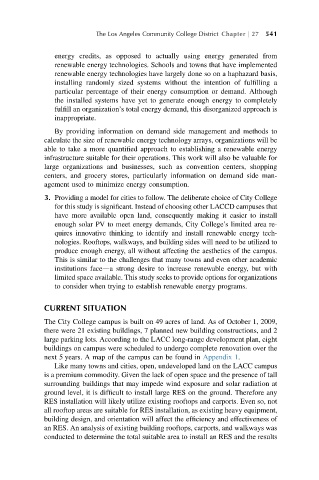Page 572 - Sustainable Cities and Communities Design Handbook
P. 572
The Los Angeles Community College District Chapter j 27 541
energy credits, as opposed to actually using energy generated from
renewable energy technologies. Schools and towns that have implemented
renewable energy technologies have largely done so on a haphazard basis,
installing randomly sized systems without the intention of fulfilling a
particular percentage of their energy consumption or demand. Although
the installed systems have yet to generate enough energy to completely
fulfill an organization’s total energy demand, this disorganized approach is
inappropriate.
By providing information on demand side management and methods to
calculate the size of renewable energy technology arrays, organizations will be
able to take a more quantified approach to establishing a renewable energy
infrastructure suitable for their operations. This work will also be valuable for
large organizations and businesses, such as convention centers, shopping
centers, and grocery stores, particularly information on demand side man-
agement used to minimize energy consumption.
3. Providing a model for cities to follow. The deliberate choice of City College
for this study is significant. Instead of choosing other LACCD campuses that
have more available open land, consequently making it easier to install
enough solar PV to meet energy demands, City College’s limited area re-
quires innovative thinking to identify and install renewable energy tech-
nologies. Rooftops, walkways, and building sides will need to be utilized to
produce enough energy, all without affecting the aesthetics of the campus.
This is similar to the challenges that many towns and even other academic
institutions faceda strong desire to increase renewable energy, but with
limited space available. This study seeks to provide options for organizations
to consider when trying to establish renewable energy programs.
CURRENT SITUATION
The City College campus is built on 49 acres of land. As of October 1, 2009,
there were 21 existing buildings, 7 planned new building constructions, and 2
large parking lots. According to the LACC long-range development plan, eight
buildings on campus were scheduled to undergo complete renovation over the
next 5 years. A map of the campus can be found in Appendix 1.
Like many towns and cities, open, undeveloped land on the LACC campus
is a premium commodity. Given the lack of open space and the presence of tall
surrounding buildings that may impede wind exposure and solar radiation at
ground level, it is difficult to install large RES on the ground. Therefore any
RES installation will likely utilize existing rooftops and carports. Even so, not
all rooftop areas are suitable for RES installation, as existing heavy equipment,
building design, and orientation will affect the efficiency and effectiveness of
an RES. An analysis of existing building rooftops, carports, and walkways was
conducted to determine the total suitable area to install an RES and the results

